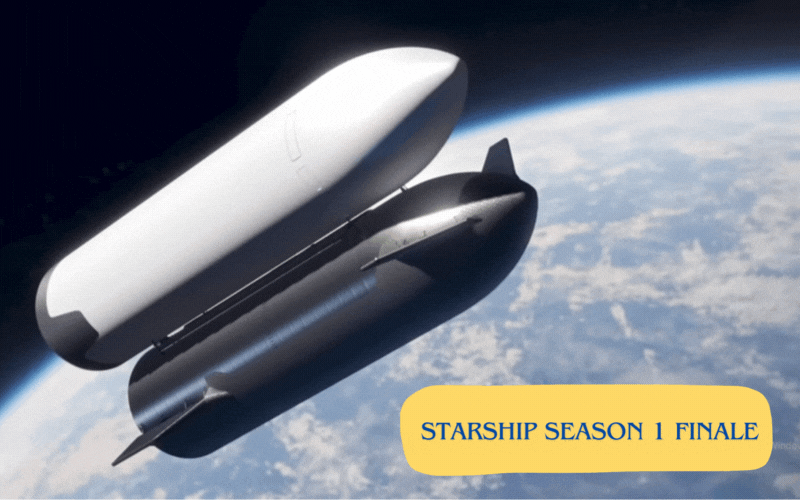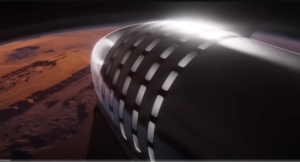The Finale of Starship Season 1: A Spectacular Journey into Space
Introduction
Today’s episode of Starship brings the high-speed excitement, spectacular views, and typical dose of confusion that we’ve come to expect from SpaceX’s ambitious ventures. As we dive into the finale of Starship Season 1 finale, we’ll explore the latest developments, key challenges, and thrilling moments that defined this journey. Let’s begin by acknowledging the impressive new renders of the Human Landing System Starship, showcasing a glimpse of what’s to come in future lunar and Martian missions.

Table of Contents
New Renders of the Human Landing System Starship
The first official update to the Human Landing System Starship design in a while brings several notable changes. Absent are the solar panels from the ship’s exterior, but we can see the outline of rectangular doors above the NASA logo and below the windows. These align with previous renderings showing four deployable solar arrays that extend and drop down alongside the body.
The landing thrusters remain in the same position, giving us a better idea of the landing gear and its deployment. We see two iterations of the lunar Starship: one with a few windows, likely the short-term Artemis 3 moonlander, and another with many windows, the future Starship for Moonbase Alpha.
Preparing for Mars: Heat Shield Tests
SpaceX is gearing up for its first mission to Mars in 2026, conducting practical tests on the heat shield material to withstand the Martian atmosphere’s entry. The composition of the Martian atmosphere differs significantly from Earth’s, being thinner and almost entirely composed of CO2. This creates atomic oxygen, a highly reactive gas, during entry, posing a unique challenge for erosion on the heat shield.
To simulate these conditions, SpaceX blasts their heat shield tiles in a jet furnace. This preparation is crucial to ensure the spacecraft’s durability during Mars re-entry.
The Final Launch of Block One Classic Starship
In the main event, SpaceX pushed the limits with the final launch of the Block One classic Starship upper stage design. The goal was to test the hardware’s endurance through a challenging re-entry and controlled water landing.
Two significant changes were made:
- Heat Shield Tiles: SpaceX removed 2100 tiles from the sides of the rocket, creating a distinct pattern resembling a receding hairline. The nose cone section also had tiles replaced with a secondary protective layer and some covered with stainless steel. This test aimed to evaluate the resilience of the stainless steel material in preparation for future catch hardware installations.
- Flight Profile: Instead of the typical belly flop descent, SpaceX increased the angle of attack, pointing the nose down towards the ground. This maneuver tested the vehicle’s control flaps’ stress tolerance and provided critical data for future missions.
Liftoff and Launch Anomalies
The launch proceeded smoothly, with a fast, clean departure from the Launchpad. All booster engines performed well, offering a stunning spectacle with the late afternoon sun enhancing visibility. However, a few anomalies occurred during the ascent.
Post stage separation and Boost back burn, the booster was set for an offshore divert, resulting in a splashdown in the Gulf of Mexico. An unusual sighting was noted: a bent communications antenna atop the launch tower and an unexpected pipe protruding from the booster. Despite these anomalies, the booster executed a clean water landing, albeit with minor fire involvement.
First Payload: A Stuffed Banana
Marking a historic moment, the first payload carried into space by a Starship rocket was a stuffed banana, serving as a zero-g indicator. This tradition adds a whimsical touch to the mission, demonstrating the lighter side of space exploration.
Raptor Engine Relight Test
During the coast phase, SpaceX tested the Raptor engine relight in a microgravity vacuum environment. This critical test ensures the engine’s ability to refire in space, a necessary capability for slowing down during future high-altitude and stable orbit missions.
Re-entry and Water Landing
The re-entry sequence began in darkness and transitioned into daylight, providing an exhilarating visual experience. The ship’s performance was commendable despite the compromised heat shield. While some front flap tiles melted and bare steel sections wrinkled, the vehicle held up under maximum aerodynamic stress. The controlled landing and subsequent splashdown showcased the spacecraft’s robustness, although a small fire ensued post-landing.
Starship Block 2: A Glimpse into the Future
With the Block One era concluding, attention shifts to Starship Block 2. This new iteration, slightly longer with increased fuel tank capacity, promises to carry over 100 metric tons of payload into low Earth orbit. The smaller payload bay, compared to Block One, is a notable change, but the advancements in engine technology and fuel efficiency make up for this.
Achieving True Orbit: The Next Frontier
The next flight will aim for a true orbit, pushing the boundaries higher and faster. Achieving a full orbit around Earth requires slowing the spacecraft down before re-entry, a challenge that SpaceX is prepared to tackle. With the Raptor engine relight proven and Block 2’s enhanced capabilities, the future of Starship looks promising.
Table: Starship Block One vs. Block Two
| Feature | Block One | Block Two |
|---|---|---|
| Payload Capacity | Unknown | Over 100 metric tons |
| Fuel Tank Length | Standard | Increased |
| Heat Shield Material | Standard | Upgraded |
| Payload Bay Size | Larger | Smaller |
| Engine Relight Capability | Tested | Proven |
| Launch Success Rate | High | To be determined |
Conclusion
The finale of Starship Season 1 has delivered a blend of high-speed excitement, spectacular views, and valuable data that will propel SpaceX’s future missions. From the latest renders of the Human Landing System Starship to the rigorous heat shield tests and the transition to Starship Block 2, the journey has been nothing short of exhilarating. As SpaceX prepares for true orbital missions, we can look forward to even more groundbreaking achievements in the realm of space exploration. Stay tuned for the next thrilling chapter in the Starship saga.
FAQs
Q1: What is the significance of the new renders of the Human Landing System Starship? The new renders provide the first official update to the design, showcasing improvements and preparations for future lunar missions, including the Artemis 3 moonlander and Moonbase Alpha.
Q2: Why is SpaceX conducting heat shield tests for Mars missions? The Martian atmosphere is composed almost entirely of CO2, which creates highly reactive atomic oxygen during entry. These tests ensure the spacecraft’s heat shield can withstand the unique erosion challenges posed by Mars’ atmosphere.
Q3: What were the key changes in the final launch of Block One classic Starship? SpaceX removed 2100 heat shield tiles and increased the angle of attack during descent to test the vehicle’s resilience and control flaps’ stress tolerance, providing critical data for future missions.
Q4: What was the first payload carried into space by a Starship rocket? A stuffed banana served as the first payload, acting as a zero-g indicator and adding a whimsical touch to the mission.
Q5: What advancements does Starship Block 2 bring? Starship Block 2 features increased fuel tank capacity, allowing it to carry over 100 metric tons of payload into low Earth orbit. Despite a smaller payload bay, its enhanced engine technology and fuel efficiency mark significant progress.














Post Comment